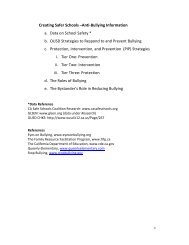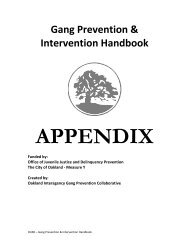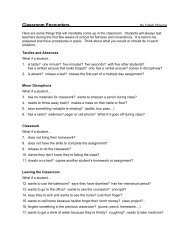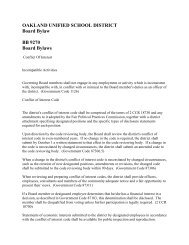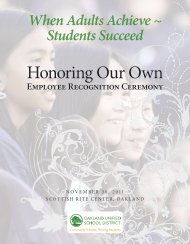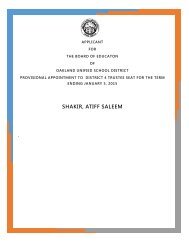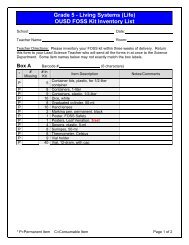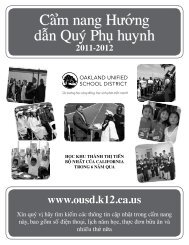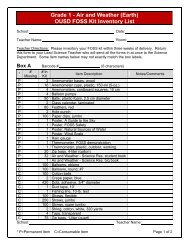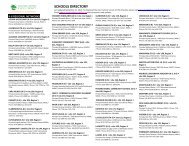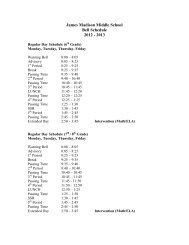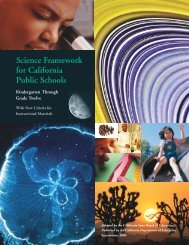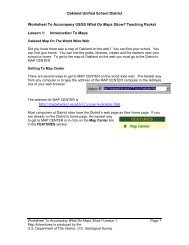Oakland Unified School District Case Study
Oakland Unified School District Case Study
Oakland Unified School District Case Study
Create successful ePaper yourself
Turn your PDF publications into a flip-book with our unique Google optimized e-Paper software.
Student learning is assessed primarily<br />
through site-developed assessments, based<br />
on the New Leaders for New <strong>School</strong>s<br />
(NLNS) assessments. These assessments<br />
are primarily paper and pencil multiplechoice<br />
tests that have been aligned to the<br />
California language arts learning standards<br />
for each grade level. After each<br />
administration of standards-based interim<br />
assessments, the school principal and<br />
instructional coaches meet with individual<br />
teachers (or grade levels as appropriate) to<br />
analyze and reflect on test results in order<br />
to create action plans to address the needs<br />
of learners who are struggling with certain<br />
standards. Teachers align their curriculum<br />
to NLNS assessments using the NLNSdeveloped<br />
ELA Standards Maps to backwards<br />
map 18 their instruction in 6 to 8<br />
week cycles. The standards maps have also<br />
helped narrow the focus of instruction<br />
each week, so that skills and strategies can<br />
be taught in a way that moves students<br />
toward mastering the content rather than<br />
just being exposed to the content.<br />
<strong>School</strong> leaders and staff strongly contend<br />
that using the quarterly assessments they<br />
have created has played an instrumental<br />
role in their ability to improve student<br />
outcomes on the end-of-year California<br />
Standards Test (CST). The shift is universally<br />
described as the shift from curriculum-embedded<br />
assessment to standardsbased<br />
assessment. One teacher describes<br />
the shift this way:<br />
I like standards-based assessments.<br />
Last year, I did [curriculum-embedded]<br />
assessments, and if you can’t<br />
read, you can [still] pass the test<br />
because of all the other projects<br />
we do around the story. When it<br />
comes CST time, the students didn’t<br />
have experience doing it on their<br />
own. Standards-based assessment<br />
has shown me where the kids are on<br />
the standards. The test actually tests<br />
what the kids can do on their own,<br />
rather than remembering everything<br />
we did all week.<br />
<strong>School</strong> leaders feel similarly enthusiastic<br />
about the new approach to literacy instruction<br />
and assessment:<br />
I hope more schools can start making<br />
this move toward having more of<br />
a standards-based approach: having<br />
expectations of kids to be the ones<br />
who are the thinkers and the learners<br />
and the readers. It’s been really<br />
exciting, the shift we’ve seen here<br />
at AWE, where kids are sitting in<br />
groups, they’re crying about books,<br />
they’re talking about books, they’re<br />
laughing about books — that just<br />
doesn’t happen, usually. For whatever<br />
reason, there has been a loss<br />
of trust in students’ ability to do<br />
that, and I’m not sure what it would<br />
take, but I really deeply hope we<br />
can regain that trust in our students’<br />
capacity to be high-level thinkers,<br />
and to not be so dependent on the<br />
teacher to make meaning of the<br />
world for them.<br />
It is important to note that the AWE staff<br />
has not been randomly experimenting with<br />
different approaches to literacy instruction<br />
and assessment. Shifts in the learning program<br />
are based on looking at the school’s<br />
achievement data and adopting practices<br />
and assessments that have been proven successful<br />
in meeting the gaps in the school’s<br />
instructional program.<br />
Staff members have worked particularly<br />
hard to implement teaching practices to<br />
12<br />
<strong>School</strong> Redesign Network at Stanford University



